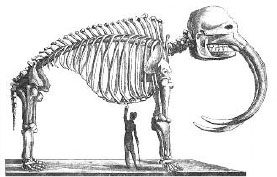With new fossil discoveries and Cuvier’s research, it was becoming more clear what sorts of creatures these prehistoric elephants really were. Jefferson accepted Cuvier’s conclusions that mastodons were extinct plant eaters. But not everyone was so sure….
Monster Tour
Jefferson’s friend Charles Willson Peale revealed his public display of the first nearly complete mastodon skeleton in his Philadelphia museum in 1802. For a pricey 50-cent fee, this marvel could be viewed “by lamp light, every evening” except Sunday. It was such a sensation that Peales’ second mastodon skeleton (his workers had unearthed two) was soon shipped off on tour. The museum owner’s son Rembrandt Peale exhibited the second mastodon in New York and then moved the show overseas to new audiences in London.
The Peales’ advertising for their mastodon exhibits made much of the enormous size of the two skeletons, proclaiming them “the LARGEST of Terrestrial Beings!” But Rembrandt built even more excitement for the traveling exhibit with claims that mastodons were not only huge but also ferocious. His advertisements called their bumpy grinders “teeth of the Carnivorous kind”—proof that mastodons were terrifying meat eaters. In Rembrandt’s opinion, mastodons were “exclusively carnivorous” giants with “an amphibious nature” that lurked in the water for prey.

AN 1816 DRAWING OF THE MASTODON ON DISPLAY IN PEALES’ PHILADELPHIA MUSEUM— COMPLETE WITH UPSIDE-DOWN TUSKS AND EXAGGERATED SIZE